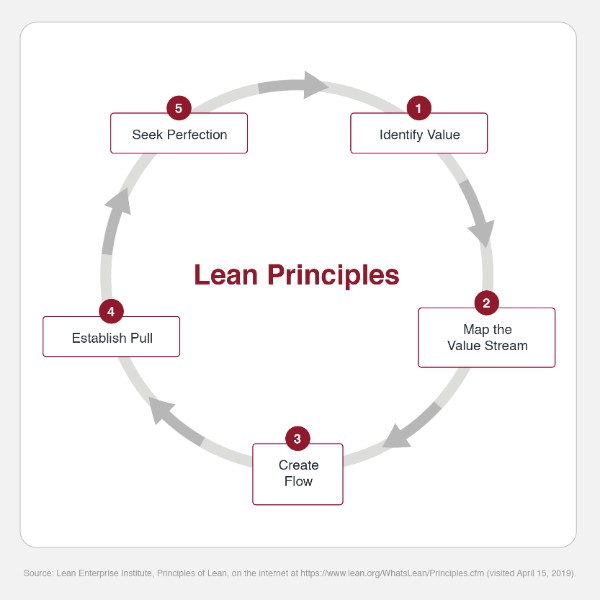For those wishing to become leaders in making organizations more efficient and effective, learning the principles of Lean is an important first step. These steps provide the framework for evaluating current processes and developing improved systems.
Much of what constitutes Lean methodology started in manufacturing, particularly with the Toyota Production System that the Japanese automaker developed in the mid-20th century. However, Lean is a process improvement methodology that can be used in all industries in any operation that involves a series of interlocking processes.
The following looks at the five principles of Lean. Each describes a critical step on the way to taking a process from inefficient to efficient, as well as making it more profitable.
The Five Principles of Lean
The following are the five principles of Lean that drive the methodology. Each is a key component in creating a culture of continuous process improvement.
Value
In Lean, value is defined by what provides value to the end user. Anything in a process that does not provide value to the end user should be eliminated. Finding value is the first step in applying Lean strategies to a process. As obvious as this seems, value can only be determined by the customer. To understand the value a customer finds in a product or service, you must first either be the customer or talk with them.
Examples of ways companies determine value are customer surveys and questionnaires. Value also can be determined by what a customer is willing to pay for a product or service.
The Value Stream
Once you have established the value, then it’s important to map out how an operation works step-by-step. This is used to determine which steps add value and which do not. This is frequently referred to as Value Stream Mapping, and it’s key to making Lean work.
Value stream includes the entire life cycle of a product, from the raw materials at the beginning to when it is disposed of by a consumer. An organization only can find the waste along this stream by mapping it in detail. Value stream mapping, in addition to process flow, includes issues such as:
- What information is flowing through the process?
- What data is being collected throughout the process?
- What forms must be completed?
- What reviews or sign-offs are required?
- What systems are involved throughout the process?
- How long does it take to get from Step A to Step B?
Remember, a value stream map does not show how a process should work. Instead, it maps out how a process actually is working. Only then can changes be made that improve it.
Flow
By defining value and developing a value stream map, it is now possible to eliminate wasted steps and create flow. Once the new process is in place, it’s important to ensure that it flows smoothly. There should be no delays or bottlenecks.
For knowledge workers, flow involves visualizing and managing your flow to ensure faster and consistent product or service delivery. By looking at flow, you also drill deeper into a process, set parameters for capacity and isolate problems that interrupt flow. Much like value stream mapping, assessing flow requires breaking down any departmental silos and looking at the entire operation.
A great example of flow is the security system at airports. Over the years, changes have been made to make the process flow better, such as additional lines and pre-approval for some passengers.
Pull
Pull is a key component of Just in Time manufacturing, something started at Toyota, the company most associated with Lean methods. The car company invented many of the tools and techniques used in Lean with its Toyota Production System.
Pull is a system in which production is not started until a customer places an order. Rather than manufacture a product based on a projection, a pull system requires only producing what customers actually order. The clear advantage to this is cutting down on inventory and elimination of unneeded work.
Toyota defines Just in Time manufacturing as “making only what is needed, when it is needed, at every stage of production. That means there is no waste, consistent quality and an even production flow.” That serves as a good definition of Pull, too.
Perfection
This involves making Lean and process improvement a part of organizational culture. This requires buy-in and support from executives, as well as those on the “front lines.” This is perhaps the most crucial step of all. Without Perfection, there is not continuous process improvement and gains made are eventually lost.
The above is just an overview of the complex, fascinating world of Lean. Knowing Lean can put you on the cutting edge of process improvement, something every company is interested in developing.


